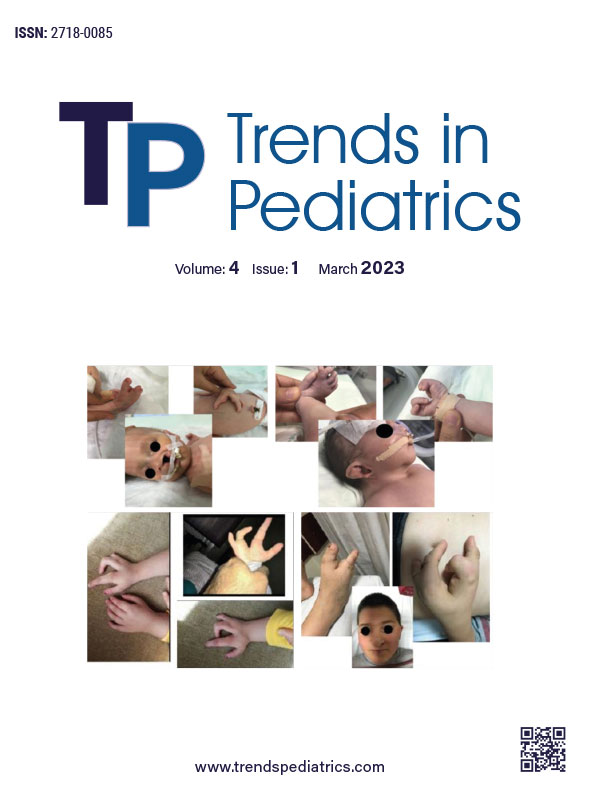Abstract
Objective: Candida species are the most common infectious agents among the pathogens responsible for nosocomial fungal infections. Transmissions in intensive care units account for a significant proportion of the mortality and morbidity associated with candida infections. The present study evaluates the prevalence, type, treatment approach, underlying risk factors, and outcomes of candida infections in patients treated in a pediatric intensive care unit in Türkiye with a dense population of children who have fled the war in Syria.
Methods: The study was conducted in the 14-bed tertiary pediatric intensive care unit of a city hospital between March 2018 and March 2019.
Results: Candida species were reproduced in the studied samples of 28 (15.7%) of the 176 patients treated in the intensive care unit during the study period. Mortality occurred in six (21.4%) patients with invasive candidiasis of varying species, namely: C. lusitaniae (n=2); C. parapsilosis (n=2); C. krusei (n=1), and C. albicans (n=1), and candida was considered the cause of mortality in five of the six non-survivors. Resistance to liposomal amphotericin-B was observed in the Candida species isolated from the non-survivors.
Conclusion: In the present study, a prolonged stay in the intensive care unit, a higher number of indwelling medical devices, the use of broad-spectrum antibiotics, the presence of an underlying condition, and renal failure were observed to increase incidence of candida infection.
Keywords: Candida, pediatric, intensive care, mortality, evalution
References
- Delaloye J, Calandra T. Invasive candidiasis as a cause of sepsis in the critically ill patient. Virulence. 2014;5:161-9. https://doi.org/10.4161/viru.26187
- Whaley SG, Berkow EL, Rybak JM, Nishimoto AT, Barker KS, Rogers PD. Azole antifungal resistance in candida albicans and emerging non-albicans candida species. Front Microbiol. 2017;7:2173. https://doi.org/10.3389/fmicb.2016.02173
- Lovero G, De Giglio O, Montagna O, et al. Epidemiology of candidemia in neonatal intensive care units: a persistent public health problem. Ann Ig. 2016;28:282-7. https://doi.org/10.7416/ai.2016.2107
- Marchetti O, Bille J, Fluckiger U, et al. Epidemiology of candidemia in Swiss tertiary care hospitals: secular trends, 1991-2000. Clin Infect Dis. 2004;38:311-20. https://doi.org/10.1086/380637
- Baykara N, Akalın H, Arslantaş MK, et al. Epidemiology of sepsis in intensive care units in Turkey: a multicenter, point-prevalence study. Crit Care. 2018;22:93. https://doi.org/10.1186/s13054-018-2013-1
- Aslan N, Yildizdas D, Alabaz D, Horoz OO, Yontem A, Kocabas E. Invasive candida infections in a pediatric intensive care unit in Turkey: evaluation of an 11-year period. J Pediatr Intensive Care. 2020;9:21-6. https://doi.org/10.1055/s-0039-1695061
- Bilgin MK, Talan L, Evren E, Altıntaş ND. Retrospective evaluation of risk factors for invasive candida infections in a medical intensive care unit. Infect Dis Clin Microbiol. 2022;4:62-72. https://doi.org/10.36519/idcm.2022.56
- Dutta A, Palazzi DL. Candida non-albicans versus Candida albicans fungemia in the non-neonatal pediatric population. Pediatr Infect Dis J. 2011;30:664-8. https://doi.org/10.1097/INF.0b013e318213da0f
- Noni M, Stathi A, Vaki I, Velegraki A, Zachariadou L, Michos A. Changing epidemiology of invasive candidiasis in children during a 10-year period. J Fungi (Basel). 2019;5:19. https://doi.org/10.3390/jof5010019
- Omrani AS, Makkawy EA, Baig K, et al. Ten-year review of invasive Candida infections in a tertiary care center in Saudi Arabia. Saudi Med J. 2014;35:821-6.
- Sanguinetti M, Posteraro B, Lass-Flörl C. Antifungal drug resistance among Candida species: mechanisms and clinical impact. Mycoses. 2015;58 Suppl 2:2-13. https://doi.org/10.1111/myc.12330
- Pfaller M, Neofytos D, Diekema D, et al. Epidemiology and outcomes of candidemia in 3648 patients: data from the Prospective Antifungal Therapy (PATH Alliance®) registry, 2004-2008. Diagn Microbiol Infect Dis. 2012;74:323-31. https://doi.org/10.1016/j.diagmicrobio.2012.10.003
- Tukenmez Tigen E, Bilgin H, Perk Gurun H, et al. Risk factors, characteristics, and outcomes of candidemia in an adult intensive care unit in Turkey. Am J Infect Control. 2017;45:e61-3. https://doi.org/10.1016/j.ajic.2017.02.022
- Montagna MT, Lovero G, Borghi E, et al. Candidemia in intensive care unit: a nationwide prospective observational survey (GISIA-3 study) and review of the European literature from 2000 through 2013. Eur Rev Med Pharmacol Sci. 2014;18:661-74.
- Guery BP, Arendrup MC, Auzinger G, et al. Management of invasive candidiasis and candidemia in adult non-neutropenic intensive care unit patients: Part I. Epidemiology and diagnosis. Intensive Care Med. 2009;35:55-62. https://doi.org/10.1007/s00134-008-1338-7
- Pappas PG, Kauffman CA, Andes DR, et al. Clinical practice guideline for the management of candidiasis: 2016 update by the Infectious Diseases Society of America. Clin Infect Dis. 2016;62:e1-50. https://doi.org/10.1093/cid/civ933
- Vasileiou E, Apsemidou A, Vyzantiadis T-A, Tragiannidis A. Invasive candidiasis and candidemia in pediatric and neonatal patients: A review of current guidelines. Curr Med Mycol. 2018;4:28-33. https://doi.org/10.18502/cmm.4.3.173
Copyright and license
Copyright © 2023 The author(s). This is an open-access article published by Aydın Pediatric Society under the terms of the Creative Commons Attribution License (CC BY) which permits unrestricted use, distribution, and reproduction in any medium or format, provided the original work is properly cited.














